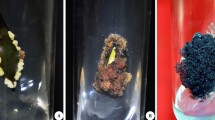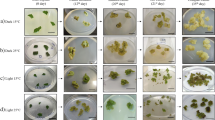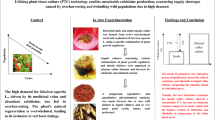Abstract
The present study is the first report on the quantitative analysis of secondary metabolites in callus cultures of Barleria prionitis L. and comparison with the mother plant. Callus was obtained from stem internode (on MS medium with 0.5 mg l−1 NAA, 0.5 mg l−1 BAP and 300 mg l−1 ascorbic acid), and leaf (on MS medium with 1.0 mg l−1 2,4-D, 0.5 mg l−1 BAP, 300 mg l−1 ascorbic acid ) explants and, multiplied by subculturing thrice at an interval of 25 days. Calli and mother plant counterparts were extracted in four solvents (methanol, ethanol, acetone, and distilled water) and examined for active compounds and antioxidant potential. Callus cultures not only preserved the mother plant’s metabolite profile but also displayed elevated levels. Leaf-derived callus surpassed stem-derived callus in most of the studied parameters. The highest total phenolic content (21.46 mg GAE g−1 FW) and total flavonoid content (24.58 mg of RE g−1 FW) were observed in methanol extract of leaf-derived callus, representing a 3-fold and 2-fold increase over mother plant leaf, respectively. Antioxidant capacity based on FRAP and DPPH assay was highest in methanol extract of leaf-derived callus (7-fold and 3-fold increase over mother plant, respectively) while ABTS activity was highest (122-fold increase) in acetone extract of leaf-derived callus. HPTLC analysis revealed enhanced concentrations of squalene (10-fold) and SME (2.3-fold) in acetone and methanol extract of leaf-derived callus, respectively, compared to mother explants. The results of RP-HPLC for phenolics showed the highest gallic acid content (99-fold increase) in ethanol extract of stem-derived callus whereas catechol was maximum (37-fold increase) in aqueous extract of leaf-derived callus. These findings suggest that callus cultures of B. prionitis L. can be a potential source of active metabolites. Further, cell suspension cultures can be produced from the callus, which could be an avenue for the large-scale production of bioactive compounds.
Key message
For the first time, active components of B. prionitis L. were determined quantitatively in callus cultures and compared with the mother plant.


Similar content being viewed by others
Data availability
The datasets generated during and/or analyzed during the current study are available from the corresponding author at a reasonable request.
References
Akkol EK, Göger F, Koşar M, Başer HC (2008) Phenolic composition and biological activities of Salvia halophila and Salvia virgata from Turkey. Food Chem 108:942–949. https://doi.org/10.1016/j.foodchem.2007.11.071
Awada R, Campa C, Gibault E et al (2019) Unravelling the metabolic and hormonal machinery during key steps of somatic embryogenesis: a case study in coffee. Int J Mol Sci 20:4665. https://doi.org/10.3390/ijms20194665
Bahorun T, Trotin F, Vasseur J (2002) Polyphenol production in Crataegus tissue cultures (Hawthorn). In: Bajaj Y (ed) Biotechnology in agriculture and forestry: medicinal and aromatic plants, 12th edn. Springer, Berlin, pp 23–49
Chandran H, Meena M, Barupal T, Sharma K (2020) Plant tissue culture as a perpetual source for production of industrially important bioactive compounds. Biotechnol Rep 26:e00450. https://doi.org/10.1016/j.btre.2020.e00450
Chatterjee T, Ghosh B (2020) Micropropagation of medicinal plants: a review. Int J Econ Plants 7:66–72. https://doi.org/10.23910/2/2020.0368
Chavan C, Mulik S, Chavan M, Adnaik R, Patil P (2011) Screening of antioxidant activity and phenolic content in whole plant of Barleria prionitis Linn. Int J Res Ayurveda Pharm 2:1313–1319
Efferth T (2019) Biotechnology applications of plant callus cultures. Engineering 5:50–59. https://doi.org/10.1016/j.eng.2018.11.006
Espinosa-Leal CA, Puente-Garza CA, García-Lara S (2018) In vitro plant tissue culture: means for production of biological active compounds. Planta 248:1–18. https://doi.org/10.1007/s00425-018-2910-1
Farrukh S (2022) A review about Barleria prionitis: a rare known shrub with potential medicinal properties. J Pharm Sci Drug Discov 1:1–7
Gangaram S, Naidoo Y, Dewir YH, El-Hendawy S (2022) Phytochemicals and biological activities of Barleria (Acanthaceae). Plants. https://doi.org/10.3390/plants11010082
Ghule B, Palve S, Rathi L, Yeole P (2012) Validated HPTLC method for simultaneous determination of shanzhiside methyl ester and barlerin in Barleria prionitis. J Planar Chromat 25:426–432. https://doi.org/10.1556/JPC.25.2012.5.7
Ghule B, Kotagale N, Patil K (2020) Inhibition of the pro-inflammatory mediators in rat neutrophils by shanzhiside methyl ester and its acetyl derivative isolated from Barleria prionitis. J Ethnopharmacol. https://doi.org/10.1016/j.jep.2019.112374
Govindaraju M, Chikkamadaiah M, Mahadevamurthy M, Vinaya, Mysore S, Singh S (2019) Assessment of phytochemicals and antioxidant activities of leaf and leaf derived callus extracts of Lepianthes umbellata (L.) Raf. Int J Pure Appl Biosci 7:198–208. https://doi.org/10.18782/2320-7051.7417
Hazrati R, Zare N, Asghari-Zakaria R, Sheikhzadeh P, Johari-Ahar M (2022) Factors affecting the growth, antioxidant potential, and secondary metabolites production in hazel callus cultures. AMB Express 20:109. https://doi.org/10.1186/s13568-022-01449-z
Jain A, Ranade R, Pritam P, Joshi N, Vavilala S, Jain A (2014) A comparative study of antioxidant activity, total phenolic and flavonoid contents in different parts of Helicteres isora L. Am J Life Sci Res 2:292–302. https://doi.org/10.11648/j.ajls.20140205.17
Jaiswal S, Dubey M, Das S, Verma A, Rao C (2010) A comparative study on total phenolic content, reducing power and free radical scavenging activity of aerial parts of Barleria prionitis. Int J Phytomed 2:155–159. https://doi.org/10.5138/ijpm.2010.0975.0185.02024
Kaur PK, Vasisht K, Karan M (2014) HPTLC method for shanzhiside esters: simultaneous quantitative analysis of barlerin, acetylbarlerin and shanzhiside methyl ester in Barleria species. J Chromatogr Sep Tech 5:246. https://doi.org/10.4172/2157-7064.1000246
Khan J, Majid A, Nazir N, Nisar M, Khan Khalil A, Zahoor M, Ihsan M, Ullah R, Bari A, Shah A (2021) HPLC characterization of phytochemicals and antioxidant potential of Alnus nitida (Spach) Endl. Acta Hortic. https://doi.org/10.3390/horticulturae7080232
Kolarević T, Milinčić DD, Vujović T, Gašić UM, Prokić L, Kostić A, Cerović R, Stanojevic SP, Tešić ŽL, Pešić MB (2021) Phenolic compounds and antioxidant properties of field-grown and in vitro leaves, and calluses in Blackberry and Blueberry. Horticulturae 7(11):420. https://doi.org/10.3390/horticulturae7110420
Kumar S, Rani A (2016) Micropropagation of vajradanti (Barleria prionitis L.): a high value antidontalgic and ethno-medicinal herb. J Phytol Res 29:1–6
Kumari P, Yadav P, Arya A, Kumar S (2013) In vitro callus production and antibacterial activity of Barleria prionitis Linn. against dental caries pathogen. Int J Bot Res 3:1–6
Lone S, Yadav A, Badkhane Y, Sharma A, Bakhshi S, Raghuwanshi D (2011) Effect of different plant growth regulators on in-vitro propagation of Barleria prionitis L. a threatened medicinal plant. Int J Pharm Bio Sci 2:B438–444
Lou-Bonafonte JM, Martínez-Beamonte R, Sanclemente T, Surra JC, Herrera-Marcos LV, Sanchez-Marco J, Arnal C, Osada J (2018) Current insights into the biological action of squalene. Mol Nutr Food Res 62(15):e1800136. https://doi.org/10.1002/mnfr.201800136
Lozano-Grande MA, Gorinstein S, Espitia-Rangel E, Dávila-Ortiz G, Martínez-Ayala AL (2018) Plant sources, extraction methods, and uses of squalene. Int J Agron. https://doi.org/10.1155/2018/1829160
Manivannan A, Soundararajan P, Park Y, Jeong B (2015) In vitro propagation, phytochemical analysis and evaluation of free radical scavenging property of Scrophularia kakudensis tissue extracts. BioMed Res Int. https://doi.org/10.1155/2015/480564
Moteriya P, Padalia H, Rathod T, Menpara D, Chanda S (2014a) Phytochemical analysis and antibacterial activity of Maytenus emarginata leaf and stem. J Pharmacogn Phytochem 3:202–208
Moteriya P, Ram J, Rathod T, Chanda S (2014b) In vitro antioxidant and antibacterial potential of leaf and stem of Gloriosasuperba L. Am J Phytomed Clin Ther 2:703–787
Murashige T, Skoog F (1962) A revised medium for rapid growth and bioassays with tobacco tissue cultures. Physiol Plant 15:473–497
Najhah M, Jaafar H, Nakasha J, Hakiman M (2021) Shoot multiplication and callus induction of Labisia pumila var. alata as influenced by different plant growth regulators treatments and its polyphenolic activities compared with the wild plant. Molecules. https://doi.org/10.3390/molecules26113229
Nidhi, Kumar U, Kumar S (2013) Identification and screening of bioactive compounds in Barleria prionitis Linn. rhizome exhibiting antibacterial activity. Int J Res Biotechnol Biochem 3:1–6
Pérez-Alonso N, Jiménez E (2011) Producción de metabolitos secundarios de plantas mediante el cultivo in vitro. Biotecnol Veg 11:195–211
Popa O, Babeanu N, Popa I, Nita S, Dinu-Parvu C (2015) Methods for obtaining and determination of squalene from natural sources. BioMed Res Int. https://doi.org/10.1155/2015/367202
Premjet D, Premjet S, Lelono R, Tachibana S (2010) Callus induction and determination of iridoid glycosides from Barleria prionitis Linn. leaf explants. Aus J Basic Appl Sci 4:4461–4467
Rameshkumar R, Satish L, Pandian S, Rathinapriya P, Rency AS, Shanmugaraj G, Pandian S, Leung D, Ramesh M (2018) Production of squalene with promising antioxidant properties in callus cultures of Nilgirianthus ciliates. Ind Crops Prod 126:357–367. https://doi.org/10.1016/j.indcrop.2018.10.031
Ranade R (2022) In vitro propagation and phytochemical characterization of Barleria prionitis L. Ph.D. Dissertation, D. Y Patil Deemed to be University, Navi Mumbai, India
Riahi L, Chograni H, Ben Rejeb F et al (2022) Efficient in vitro regeneration of the endangered species Artemisia arborescens L. through direct organogenesis and impact on secondary metabolites production. Hortic Environ Biotechnol. https://doi.org/10.1007/s13580-021-00400-8
Sharma P, Sharma G, Shrivastava B, Jadhav H (2014) Evaluation of antioxidant potential of Barleria prionitis leaf and stem. Am J Phytomed Clin Ther 2:1177–1186
Shukla P, Singh A, Gawri S, Alexander A, Sonawane S (2011) In vitro propagation of Barleria prionitis Linn. and its antibacterial activity. Int J Pharm Prof Res 2:198–200
Singh R, Arya S, Arora K, Chodhurary M, Arya ID (2015) Micropropagation of Barleria prionitis L. var. dicantha: an ethnomedicinal plant. Adv For Sci Cuiabá 2:73–78. http://periodicoscientificos.ufmt.br/index.php/afor/article/view/2651
Singh S, Kumar M, Dwivedi S, Yadav A, Sharma S (2023) Distribution profile of iridoid glycosides and phenolic compounds in two Barleria species and their correlation with antioxidant and antibacterial activity. Front Plant Sci. https://doi.org/10.3389/fpls.2022.1076871
Sun Z, Zhan H, Wang C et al (2022) Shanzhiside methy lester protects against depression by inhibiting inflammation via the miRNA-155-5p/SOCS1 axis. Psychopharmacology 239:2201–2213. https://doi.org/10.1007/s00213-022-06107-7
Supritha P, Radha KV (2018) Estimation of phenolic compounds present in the plant extracts using high pressure liquid chromatography, antioxidant properties and its antibacterial activity. Indian J Pharma Edu Res 52:321–326
Terpinc P, Čeh B, Ulrih NP, Abramovič H (2012) Studies of the correlation between antioxidant properties and the total phenolic content of different oil cake extracts. Ind Crops Prod 39:210–217. https://doi.org/10.1016/j.indcrop.2012.02.023
Acknowledgements
Authors are thankful to Dr. B.V. Ghule, Institute of Pharmaceutical Education and Research, Wardha, Maharashtra, India for providing guidance and laboratory facilities and SME standards for HPTLC. Support and resources provided by Dr. Debjani Dasgupta, Director, School of Biotechnology and Bioinformatics, D.Y. Patil Deemed to be University, Navi Mumbai are gratefully acknowledged.
Funding
The authors declare that no funds, grants, or other support were received during the preparation of this manuscript.
Author information
Authors and Affiliations
Contributions
NJ: conception of the idea, experiment planning, interpretation of results and manuscript preparation, RR: conduction of experiments, and interpretation of results, SK: interpretation of results, data analysis and manuscript review.
Corresponding author
Ethics declarations
Conflict of interest
The authors declare that they have no conflict of interest.
Additional information
Communicated by Sergio J. Ochatt.
Publisher’s Note
Springer Nature remains neutral with regard to jurisdictional claims in published maps and institutional affiliations.
Rights and permissions
Springer Nature or its licensor (e.g. a society or other partner) holds exclusive rights to this article under a publishing agreement with the author(s) or other rightsholder(s); author self-archiving of the accepted manuscript version of this article is solely governed by the terms of such publishing agreement and applicable law.
About this article
Cite this article
Ranade, R., Joshi, N. & Kudale, S. Comparative secondary metabolite expression in callus cultures and mother plant in Barleria prionitis L.. Plant Cell Tiss Organ Cult 155, 653–663 (2023). https://doi.org/10.1007/s11240-023-02585-5
Received:
Accepted:
Published:
Issue Date:
DOI: https://doi.org/10.1007/s11240-023-02585-5




